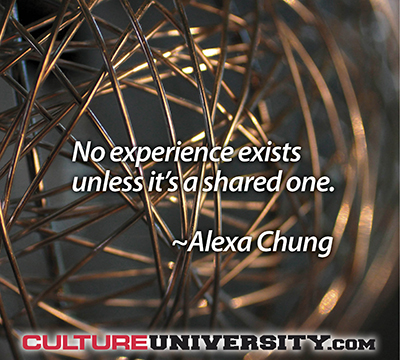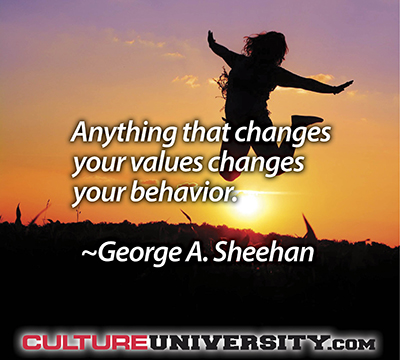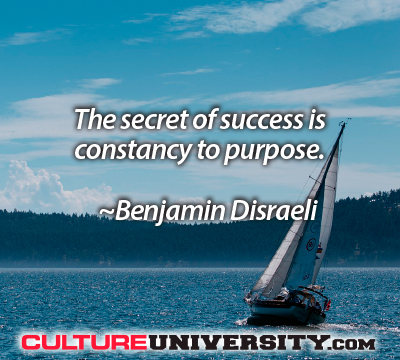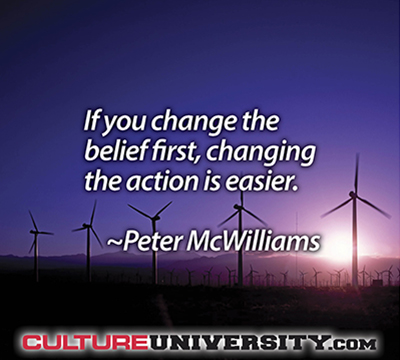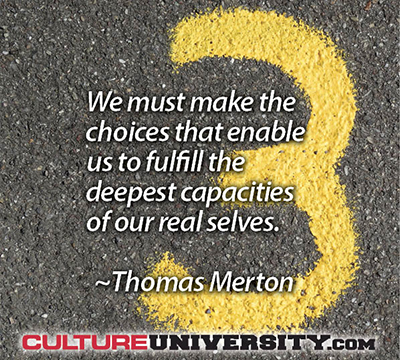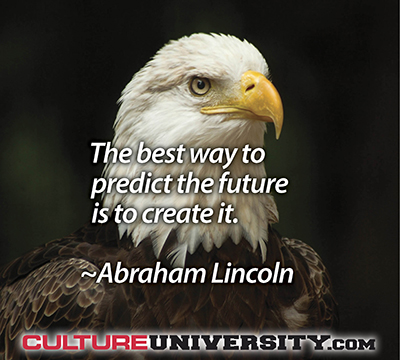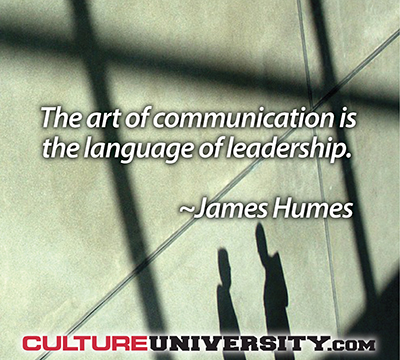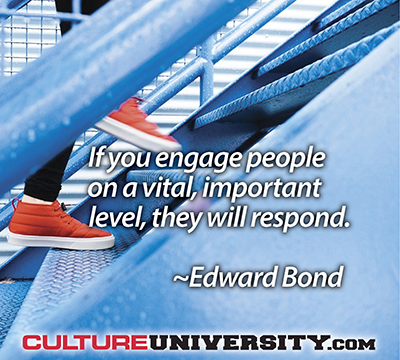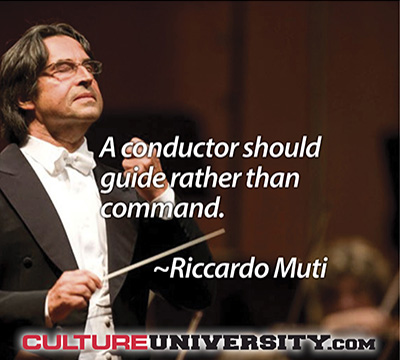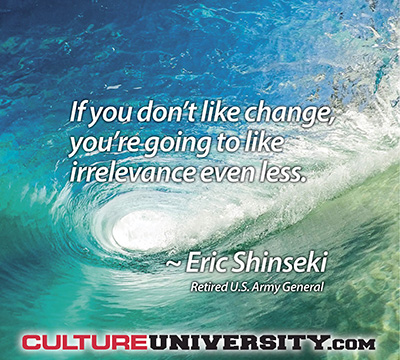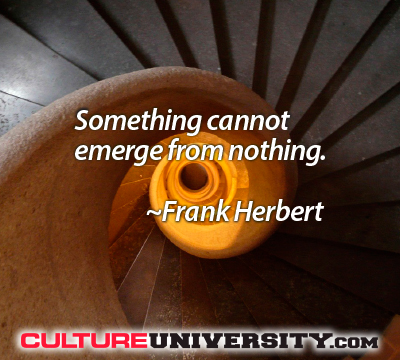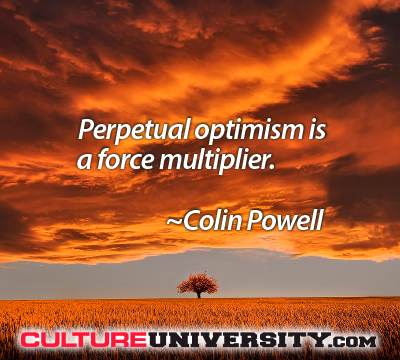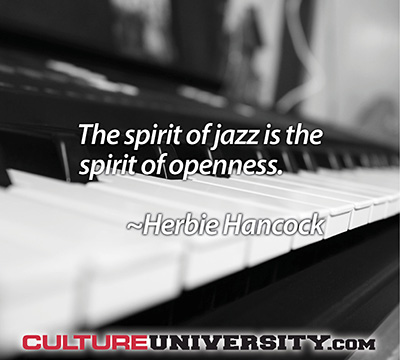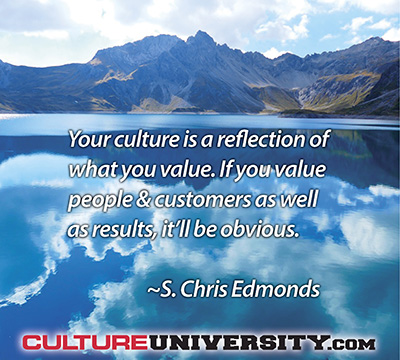Culture is not about employee happiness, how an organization feels, or about employee morale. Culture isn’t casual dress or foosball tables. Culture is multi-dimensional and interconnected. Culture is unique and complicated because people are unique and complicated.

Positively impacting society on a global scale through culture awareness, education and action.
What do you look for when hiring new leaders or team members for your organization? Do you look at skills or at attitude, or both?
Should you be looking at something else?
My admiration for Challenger brands—brands that look squarely in the eyes of the incumbents, the Goliaths of a category, and say “There is a better way and here it is”—stems from a discipline and devotion to their Purpose that isn’t swayed by fashion, trend or whim. They remain focused on the reason their founders began the company to start with.
There’s a silent power within your organization that’s quietly moulding the patterns of behavior that will determine your culture. A survey probably won’t detect it, but identifying and shifting it will have a significant impact on performance. We’re not talking about values or behaviors here, but something far less universal and more specific to individual organizations. The dominant, but tacit, influencer that has the capacity to both limit and liberate a business: our shared organizational beliefs.
According to Josh Bersin, demographic upheaval coupled with digital technology has greatly contributed to a rapid increase in the rate of change. This accelerated rate is, in turn, leading to new social contracts and business considerations. Bersin is responsible for long-term strategy at Bersin by Deloitte and is frequently published in Forbes.com and Chief Learning Officer magazine. He cites an MIT study revealing that 90% of CEOs said their company is experiencing disruption. Ninety percent! Given these turbulent times, the conversation about culture is more relevant than ever.
Passion and excitement, as well as judgment and fear, characterize the current political environment in the United States. The recent election was the most surprising call for change in government in my lifetime, and it was also a call for meaningful culture change. Government agencies must prepare to accelerate improvements, but the current culture and leadership of these agencies will likely be the greatest barriers to success.
To “do less, better” isn’t something most leaders and their organizations embrace. The seemingly more attractive (and logical) option is to do more and more – the theory being the more markets, products, and businesses a company engages in, the better the results. This is not true.
Do Less Better is a strategy and a culture; it’s also the name of my book. And for organizations and their leaders, the proponents of this discipline worship focus, loathe complexity, and enjoy success.
Workplace culture is shaped from the top down. One of the costliest mistakes to organizations is the inability or unwillingness of its leaders to successfully facilitate difficult conversations. The difficulty may lie in the manager’s skill level. He or she simply doesn’t know how to coach an employee on a performance issue. Or a leader may be embarrassed to talk with an employee about careless social skills. Or the difficulty may be a more complex cultural issue that goes unseen until the problem becomes national news.
Your CEO probably doesn’t wake up in a cold sweat thinking about your organization’s onboarding program, but maybe (s)he should. It shocks me that onboarding doesn’t have a more elevated importance in many organizations and isn’t more carefully created to support an organization’s culture. Often, the connection between onboarding and strategy isn’t clear, and details about what makes that organization unique aren’t discussed in detail, if at all, and onboarding is deemed ‘just’ training … a necessary evil.
This post is the last in a series of five articles describing a major arts-based leadership development programme at Oxford University’s Saïd Business School, designed and run over a four-year period by Dr. Mark Powell, one of the authors of this article. Previous posts have looked at the way in which delegates to the programme worked with dancers, actors and jazz musicians. This final post explores the most ‘hands-on’– and for many delegates the most emotional – element of the programme: the experience of conducting a small chamber choir.
Disturbing employee quotations
“He would find a hole in the data and then explode.”
“I would see people practically combust.”
“There are so many people running for the door not just because the ship is sinking, but because the captain of the ship is screaming at them, blaming it on them, and telling them it’s their fault.”
“The joke in the office was that when it came to work/life balance, work came first, life came second, and trying to find the balance came last.”
“You learn how to diplomatically throw people under the bus.”
I often wonder how many organizations truly put the effort into understanding how culture is fundamental to their business success and how to optimize such to bring their desired culture into the fabric of the organization.
For the sake of common understanding, let’s define culture as:
‘Influencing patterns’ that people consistently and congruently experience over time which emerge as the norms, beliefs, values and practices that guide people in their perspectives, attitudes, decisions and behaviors.’
The following opinion is an extended look into “The Force Multiplier Theory.” It’s a concept I’ll introduce below, and it’s one we routinely use in helping organizations, teams, and leaders to understand the role of culture in organizational performance and effectiveness.
The overarching idea isn’t rocket science. Seemingly, whenever we share this perspective with people they always nod their heads in agreement and say, “absolutely,” or “we really need that.” Yet, as basic as the idea might seem, we still see organizations struggle with this concept and fail to invest in it, or not to its full potential.
This post is the fourth in a series of five articles describing a major arts-based leadership development programme at Oxford University’s Saïd Business School, designed and run over a four-year period by Dr. Mark Powell, one of the authors of this article. The aim was to create a new culture of ‘open mindedness’ among the senior project managers of a UK oil and gas exploration company, encouraging them to interact more effectively with the other stakeholders in their capital projects and enhancing their ability to improvise in the face of rapidly changing situations.
The articles and expertise found here on Culture University and Constructive Culture provide a fantastic foundation for a leader to learn how a purposeful, positive, productive culture operates. From making values as important as results to creating an organizational constitution to evaluating climate and relationships—that critical information is readily available.
The tough part isn’t gaining the knowledge about creating a healthy work culture. The tough part is implementing these practices and maintaining that healthy culture, every interaction, every day.
